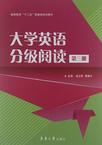大学英语分级阅读-第三册
2012-9
东华大学出版社
陈亚芬,高蕴华 编著
151
238000
《高等教育“十二五”部委级规划教材:大学英语分级阅读(第3册)》选编的阅读材料严格遵照上述标准进行选择,从而确保同一级别阅读材料难度符合实际级别水平,避免出现以往因阅读材料难度不一造成学生无所适从的现象,大大提高了阅读材料的使用效率,有助于快速提升学生的阅读能力。
同时,《高等教育“十二五”部委级规划教材:大学英语分级阅读(第3册)》内容涵盖面广,从学习者实际出发,把英语学习中接触较多、需求广泛的题材编辑为八大板块,分别以文化、教育、科技、经济、医药卫生、政治、法律和生物等领域的相关文章为主题构成全书的八个单元。每个单元配有一定的翻译、阅读理解和完型填空,帮助学生巩固和消化阅读材料的内容。
《高等教育“十二五”部委级规划教材:大学英语分级阅读(第3册)》阅读难度符合蓝斯分级区间(1200L-1300L),同时,每个单元的选材在相应的题材范围内。
Unit 1 Good old days
Text A One Small Stone, Unforgotten
Text B Hard Times, a Helping Hand - A Yuletide Story
Supplementary Exercises
Unit 2 Elite Education and Top University
Text A Elite Education and Top University
Text B Final Countdown: Top 10 Common Errors when Building a
World-Class University
Supplementary Exercises
Unit 3 Computer Testing
Text A Working with the Chaos Monkey
Text B How to Write Without Writing
Supplementary Exercises
Unit 4 Business World
Text A Another Digital Gold Rush
Text B The Symbolic Power of the Euro
Supplementary Exercises
Unit 5 Body Talks
Text A Headache
Text B Hypertension
Supplementary Exercises
Unit 6 War and Terrorism
Text A Terrorized by 'War on Terror' ...How a Three-Word Mantra Has
Undermined America
Text B Iraq: Who Won the War?
Supplementary Exercises
Unit 7 One Way to Achieve Humanity
Text A Pros & Cons of the Death Penalty
Text B What is Law?
Supplementary Exercises
Unit 8 The Science of Our Lives
Text A The Nature of Science and Biology
Text B Smallpox the Weapon-You Shall Reap What You Have Sewn
Supplementary Exercises
Key
References
8 There does not appear to be a direct relationship between caffeine and chronic hypertension, even though caffeine intake can cause an acute (rapid but brief) increase in blood pressure. This may be due to the fact that tolerance to caffeine develops rapidly. 9 Chronic overuse of alcohol is a potentially reversible cause of hypertension. Five percent of hypertension is due to alcohol consumption and 30 to 60 percent of alcoholics have hypertension. Alcohol-induced hypertension is more likely to occur in women than men. Diet and Hypertension 10 Sodium intake has been a primary target for hypertension control, though it is ranked fourth as the lifestyle factor associated with hypertension. About 50 percent of individuals appear to be "sodium sensitive." This means that excessive sodium intake tends to increase blood pressure in these groups of people, and they do not appear to excrete excessive amount of salt via the kidneys. Sodium-sensitive individuals include the elderly, obese individuals, and African Americans. The Dietary Guidelines for Americans recommend that adults consume no more than 2,400 milligrams of sodium daily. There are a number of ways to limit sodium in the diet, including: * Do not use salt at the table * Check food labels for sodium content * Choose unprocessed foods * Limit processed meats and cheeses * Limit pickled meats and vegetables * Limit salty snacks * Limit intake of soy sauce, BBQ sauce, and other condiments and foods that may be high in sodium 11 Potassium supplements (2-4 grams daily) have been shown to moderately decrease blood pressure. Fruits and vegetables are excellent sources of potassium. The Dietary Guidelines for Americans recommend that adults consume at least 3,500 milligrams of potassium daily. A diet high in fruits and vegetables has been linked to a decreased risk of both hypertension and stroke. Foods high in omega-3 fatty acids have positive effects on hypertension and cardiovascular disease by relaxing arteries and thinning the blood. In addition, several studies have demonstrated that individuals with hypertension may benefit from daily doses of calcium (800 mg) or magnesium (300 mg). 12 The DASH Eating Plan 13 Research has shown that a diet that is low in sodium but rich in calcium, potassium, and magnesium can decrease blood pressure, especially among African Americans. This eating plan is called the DASH (Dietary Approach to Stop Hypertension) eating plan and it is as effective in decreasing blood pressure as some medications commonly used to treat hypertension. The DASH eating plan is based on 2,000 calories a day with18 percent of the calories coming from protein, 55 percent from carbohydrates, and 27 percent from fats. The eating plan contains less fat than the Food Guide Pyramid, more fruits and vegetables, and includes a serving of nuts. 14 Pharmacological Treatment of Hypertension 15 Hypertension is commonly treated with medication, and a combination of two or more drugs is common. Patients are usually given a diuretic to help them excrete excess fluids. However, most diuretics also cause excretion of potassium in the urine, and individuals on diuretics should monitor their potassium intakes. Drugs used to control hypertension include beta-blockers which act to slow heart rate and cause some vasodilation (widening of the lumen, or interior, of blood vessels).Drugs that contain calcium channel blockers or angiotensin-converting enzyme (ACF,) inhibitors also cause vasodilation. ……
